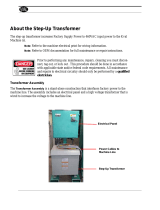
B-4
OPERATION
B-4
GENERAL DESCRIPTION
The Square Wave TIG 275 is a constant current, single
range square wave AC/DC TIG (GTAW) arc welding
power source with built-in high frequency stabilization.
It also has stick (SMAW) capability. A TIG Pulser Kit,
Power Factor Capacitor Kit, and a Water Solenoid Kit
are available as field installed options.
The Square Wave TIG 275 includes advanced features
such as Presettable Digital Meters, Auto Balance™, 2-
Step/4-Step operation, adjustable Down slope Time
control and Fan as Needed. It also features Twist Mate
connections for the electrode and work leads. In addi-
tion, fixed preflow and variable post flow timers are
included to control the shielding gas, as well as the
water flow when using the optional water solenoid.
RECOMMENDED PROCESSES AND
EQUIPMENT
The Square Wave TIG 275 is recommended for the TIG
(GTAW) and stick (SMAW) welding processes within its
output capacity of 5 to 315 amps, on both AC and DC
polarity. It is compatible with all Magnum TIG acces-
sories, as well as many industry standard items, such
as TIG torches, hoses, and water coolers.
DESIGN FEATURES AND ADVANTAGES
• Meets NEMA CLASS II (40) and IP21 environmental
certification. CSA NRTL/C certified (Domestic and
Canadian Models Only).
• Meets IEC-974-1 and IP21 environmental certifica-
tion. CE certified (European Model Only).
• Built in Digital Ammeter and Voltmeter for precise
process control. When not welding, the digital amme-
ter displays the peak current set with the output con-
trol knob. This allows the user to easily preset the
peak current within the full output range of the
machine. This includes a persistence feature which
captures and continues to display the peak welding
current and it’s corresponding voltage for five sec-
onds after the weld is completed.
• AC Wave Balance control knob provides flexibility to
the customer. Set it to the Auto Balance position and
the circuitry automatically provides the proper
amount of cleaning and penetration for normal AC
TIG welding. For special applications simply dial in
the amount of cleaning and penetration needed.
• Fan As Needed (FAN) circuit turns ‘ON’ the fan only
when cooling is needed. FAN minimizes the amount
of dust, dirt, and other foreign material drawn into the
machine. A build up of these materials can cause
excessive operating temperatures and nuisance shut
downs.
• 2-STEP/4-STEP TIG/STICK mode control switch. 4-
STEP mode requires the use of an optional Arc Start
Switch. This welding mode reduces fatigue by elimi-
nating the need to manually control the weld current
during the weld.
• Down Slope Time control is active in 4-STEP TIG
mode. It controls the amount of time (approximately
1 to 10 seconds) it takes the weld current to ramp
down from the Preset level to 25% ±10% of that level.
• Post Flow Time control is active in the 2 and 4-STEP
TIG modes. It controls the amount of time (approxi-
mately 5 to 50 seconds) the shielding gas flows after
the weld is completed.
• Robotic Interface connection on the PC board can be
connected to the machines Remote Receptacle for
automated welding procedures. This interface allows
remote control of the trigger and output current of the
machine as well as providing a signal when the weld
is established.
(For details contact the Lincoln Automation Center)
• Built in High Frequency Generator automatically per-
forms in the correct mode. If the machine is in STICK
mode, the HF stays ‘OFF’. IF the machine is in DC
TIG mode, the HF comes ‘ON’ and stays on until the
arc is established. IF the machine is in AC TIG mode,
the HF comes ‘ON’ and stays on continuously to sta-
bilize the arc.
• Automatic Local/Remote current selection. The
machine automatically senses if an Amptrol, Arc Start
Switch or TIG Pulser is plugged in and transfers cur-
rent control from local to remote.
• Built in preflow time of 0.5 seconds. Preflow time is
eliminated if welding restarts during the pervious
weld’s post flow. This avoids unnecessary delays
when making repeated welds.
• Simple dial and switch design provides the customer
with flexible control of the welding process without
unnecessary complication. Controls which are not
needed in the weld mode selected are automatically
locked out.
• Twist Mate connectors are provided for the electrode
and work connections. This style connector makes
the gas and current connections for the TIG torch at
the same time. (Adapter plugs are provided)
SQUARE WAVE TIG 275





















